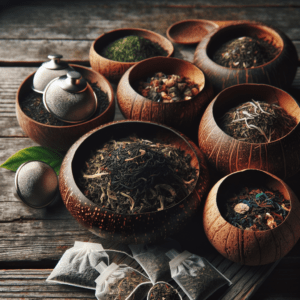A fascinating look at the evolution of tea infusers throughout history.
The History of Tea Infusers
From simple mesh bags to elaborate designs, tea infusers have a rich history. Discover how they have evolved over the years. Tea infusers have a rich history that dates back centuries, playing an integral role in the enjoyment of this beloved beverage. From their humble beginnings to the modern designs we see today, the evolution of tea infusers is a fascinating journey that reflects the cultural and technological developments of the time.
Early Origins
The concept of infusing tea dates back to ancient China, where tea drinking first originated. Historically, loose-leaf tea was brewed by simply steeping the leaves in a pot of hot water. However, as tea drinking became more widespread, the need for a more efficient and convenient method of brewing emerged.
The invention of the tea infuser can be traced back to the Ming Dynasty (1368-1644), when tea enthusiasts began using small, handheld mesh baskets to contain the tea leaves during the brewing process. These early infusers were often made from bamboo or metal and allowed for easy removal of the leaves once the desired strength had been achieved.
European Influence
As trade routes expanded and tea drinking spread to Europe, the concept of using infusers to brew tea also gained popularity. In the 17th and 18th centuries, European tea drinkers began using metal infusers, often in the form of small tongs or clamps, to steep their tea leaves in individual cups.
During this time, the design of tea infusers also became more intricate and decorative, with delicate patterns and ornate handles adorning these functional objects. Infusers were not only practical brewing tools but also served as status symbols, reflecting the refinement and sophistication of their owners.
Industrial Revolution
The Industrial Revolution brought about significant advancements in manufacturing processes, leading to the mass production of consumer goods, including tea infusers. With the advent of new materials such as stainless steel and aluminum, infusers became more durable and affordable, making them accessible to a wider audience.
Innovations in design also emerged during this period, with the introduction of perforated metal balls and novelty shapes such as teapots, animals, and even miniature houses. These whimsical infusers added a touch of charm and amusement to the tea-drinking experience, appealing to consumers of all ages.
Modern Times
In recent decades, the market for tea infusers has expanded exponentially, driven by a growing interest in specialty and artisanal teas. Today, consumers can choose from an extensive array of infuser designs, ranging from classic stainless steel balls to silicone novelty shapes and elegant glass vessels.
The focus on functionality and convenience has also led to the development of innovative infuser designs, such as collapsible silicone models for on-the-go brewing and large-capacity infusers for brewing pots of tea. Additionally, environmentally conscious consumers have embraced eco-friendly options, including biodegradable tea bags and reusable mesh infusers.
The Future of Tea Infusers
As the demand for high-quality teas continues to rise, the future of tea infusers looks promising. Advancements in materials and manufacturing techniques will likely result in even more durable, efficient, and aesthetically pleasing infuser options. Furthermore, with an increased emphasis on sustainability, we can expect to see a greater focus on eco-friendly and reusable infuser solutions.
In conclusion, the history of tea infusers is a testament to the enduring appeal of tea as a beverage and the ingenuity of human creativity. From ancient origins to modern innovations, tea infusers have evolved to meet the changing needs and preferences of tea enthusiasts around the world. As we look ahead, it is clear that tea infusers will continue to play a vital role in enhancing the tea-drinking experience for generations to come.




